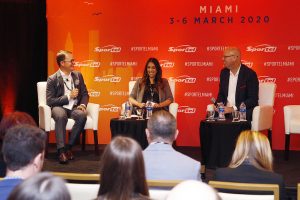IRONMAN Group Goes Virtual; Facebook Watch Is at Center of Strategy
The effort engages triathlon fans in a new way and provides coverage of complete events
Story Highlights
For Matthieu Van Veen, chief revenue officer, The IRONMAN Group, and his team, the challenge was simple: how to use social-media platforms to give IRONMAN triathlon fans a chance to get closer than ever to the sport they love. As a mass-participation sport, IRONMAN found that its core fans and athletes were underserved by the traditional media market, where live coverage of a 10-hour event was simply not an option.
Enter Facebook Watch and its ability to give IRONMAN a platform that engages its community in a whole new way and also provides a great outlet for coverage of complete IRONMAN events.

Matthieu Van Veen of the IRONMAN Group says Facebook Watch allows triathletes and fans to consume more content than ever.
“We have 280,000 competitors and a big community that was starved for content,” says Van Veen. “That helped lead us to the initial conversation with Facebook as it is a platform that brings people together.”
But now, with the world in a health crisis, IRONMAN has needed to postpone and even cancel some of its upcoming events, and the team at IRONMAN has decided to go virtual, with a virtual-racing series set to debut on Facebook Watch on April 4.

From left: IRONMAN Group’s Matthieu Van Veen, Facebook’s Devi Mahadevia, and SVG’s Ken Kerschbaumer discussed how IRONMAN Group makes the most of Facebook Watch at Sportel Americas.
“We believe that, under extraordinary circumstances such as these, athletes should be able to maintain the structure and continuity that training and competition provides,” says Andrew Messick, president/CEO, The IRONMAN Group. “The IRONMAN Virtual Club is an innovative digital platform that enables our athletes to continue training with purpose, remain connected to our community, and [have] an opportunity to compete through the IRONMAN VR Series.”
Athletes will compete in traditional age-group categories and for selected virtual races. They will also have the opportunity to earn qualifying slots to the 2020 IRONMAN 70.3 World Championship, set to be held in Taupo, New Zealand, in November.
The format and distances may vary each race weekend. The IRONMAN Virtual Club platform will use connected devices and be compatible with most wearable technology and app trackers.

Devi Mahadevia of Facebook says the IRONMAN community is a natural fit for Facebook Watch.
Devi Mahadevia, director, emerging and digital sports partnerships, Facebook, says that there are more than 40,000 fitness-related groups on Facebook and that the communities on Facebook are built by the athletes.
“When you marry those groups with the right content, the magic happens,” she says. “When the groups share content, they become the marketing channel and drive where the content goes.”
The IRONMAN season consists of full-distance triathlon events, and the IRONMAN production team uses seven cameras (four on motorbikes, two located at the transition areas, and a drone) and a bonded-cellular backpack to send the signals to Boulder, CO, where the announcers are located.
“What interested us in Facebook is the ability to be non-traditional and engage people when they are watching the content,” says Van Veen. “With a 10-hour window, how do you keep people watching? And how could we make things like polls or the ability to ask a question seamless to the user?”
While the races are going on, the IRONMAN team gets to see viewers from around the globe join as they wake up. The “good morning from the U.S.!” or “Good morning from Japan!” messages hit the chat board, and the engagement climbs. More than a million people watch over an hour of IRONMAN content in one sitting a year, so the engagement is there. And then the questions start coming in to the announce team.
“They ask questions that really matter about things like nutrition strategy,” says Van Veen, “and our announcers can react to the questions, which means greater engagement.”
Adds Mahadevia, “The question tool brings viewers into the broadcast, and they get more involved. IRONMAN has gotten 5,000 responses from the audience using these tools.”
The platform also lets IRONMAN know more about what the viewers are doing while they are watching the races. Triathletes not competing in the competition on Facebook Watch will tune in during their own marathon or triathlon training sessions, and even the sponsors can get involved during the broadcasts.
“Our sponsors can be broadcasters as we give them the ability to put the content into their Facebook page so that people can watch it in other groups,” says Van Veen. “The more the better.”
During the races, the IRONMAN team also created edited clips for things like first out of the water and tagging partners on a minute-to-minute basis. And the athletes also respond to the chat trends. Heather Jackson, a U.S. triathlete, once held a banana in her hand while riding for miles, and the chat feed lit up with viewers cracking jokes and wondering what was going on. The production crew responded by creating “Banana split times,” and, at the next race, Jackson herself embraced it with complete banana racing kit and bike.
“It shows the power of being relevant to this community,” says Van Veen.
In the past two years, more than 5 million people have watched at least one minute of IRONMAN content on Facebook Watch. Much of that is due to the groups, where authentic social relationships are the glue, and also to the sponsors and even the tourism boards for locations where the races are held.
“The tourism boards can showcase their destinations, and it is a meaningful platform to promote destination events,” says Van Veen. “They aren’t just targeting eyeballs but our community, which helps decide the next locations.”
The creation of Facebook groups is key, and Mahadevia says that anyone can start a page and start figuring out how to organize video content with Creator Studio, which provides data related to watch times and engagement that can help hone the kind of content created.
“Two factors drove our partnership with IRONMAN,” she explains. “They have a strong community on Facebook, and it isn’t just the size of the audience but how engaged they are that fuels content distribution. IRONMAN uses our tools and best practices, and that is important as we have a ton of best practices and case studies.”
The revenue model for IRONMAN is focused on using Facebook ads to convert those who are watching the content to sign up for races.
“It has had a positive impact on our business,” notes Van Veen. “We sell registrations for our events and get people into or back into the sport. They will see it and then go out, buy a bike, and start training.”
The results, he adds, have been amazing. IRONMAN sees a 14.6X return on investment in ad spends. Partners drive ticket and merchandise sales, and IRONMAN gets to keep 100% of sponsorship revenues.
IRONMAN also just built a new studio in Tampa Bay, FL, and is poised to launch an OTT app that will target the most engaged triathletes with meaningful and purposeful content.
But, until the real-world competitions resume, the virtual races will be front and center. The coverage will follow the competing age-group athletes through user-generated content shared on the interactive platform, allowing athletes to see how they match up against fellow competitors through live look-ins and leaderboard updates.
Additionally, on selected Mondays following race weekends, the IRONMAN VR Rolldown Show will provide the best action from the weekend and an interactive live awarding of the 2020 IRONMAN 70.3 World Championship qualifying slots.
During the live coverage, the IRONMAN Foundation will also run Facebook fundraisers to provide support for traditional-event host communities.
